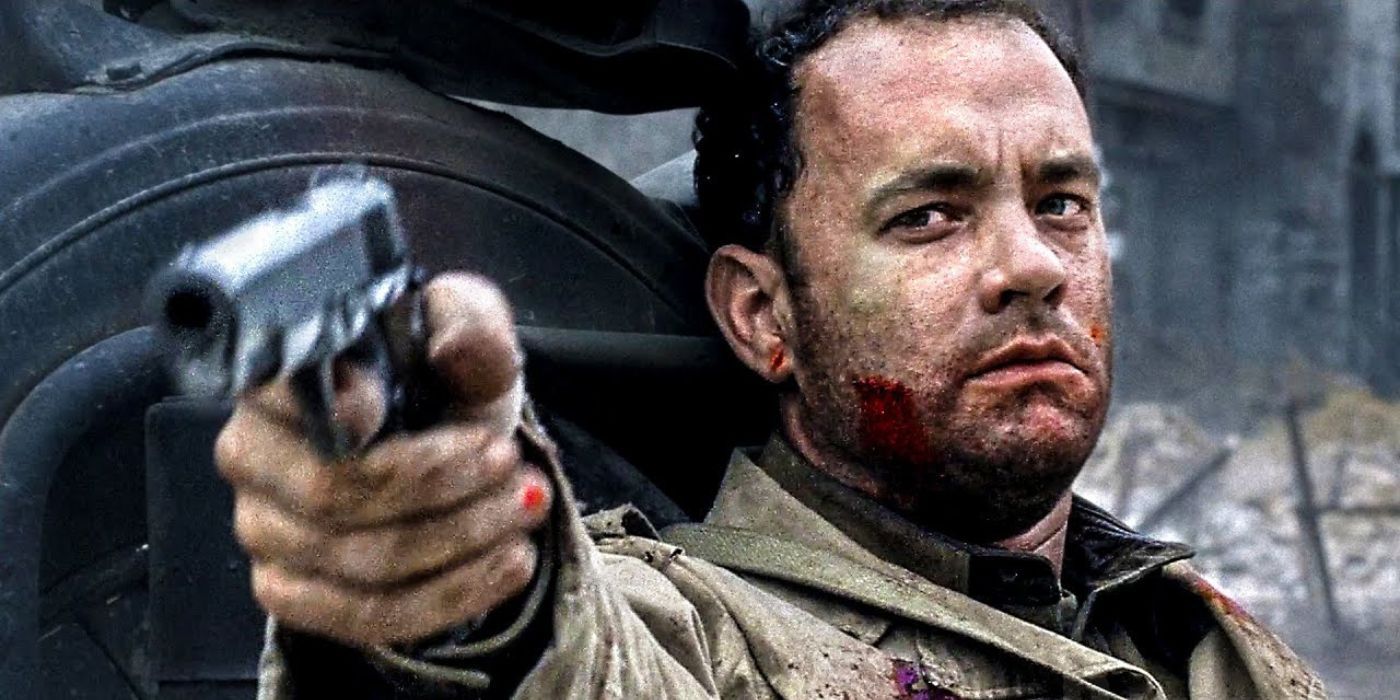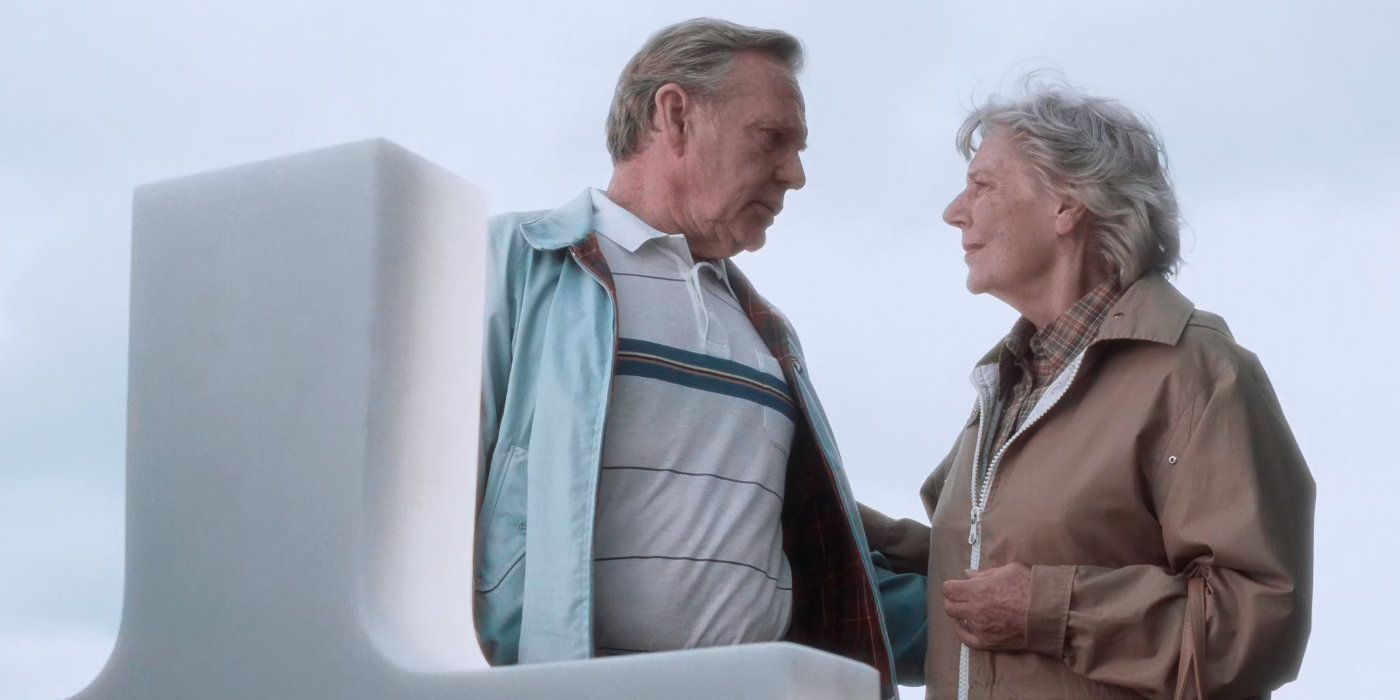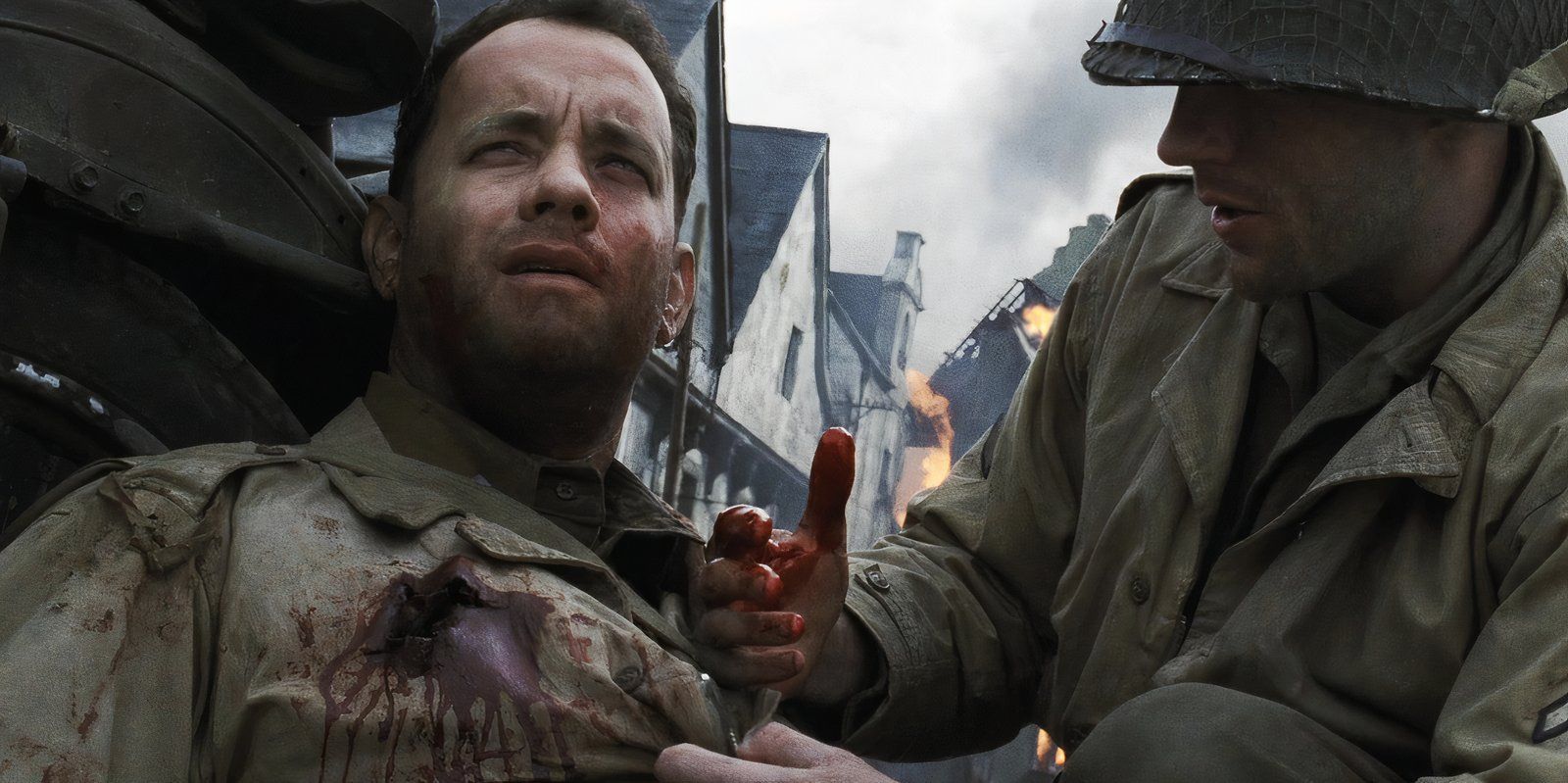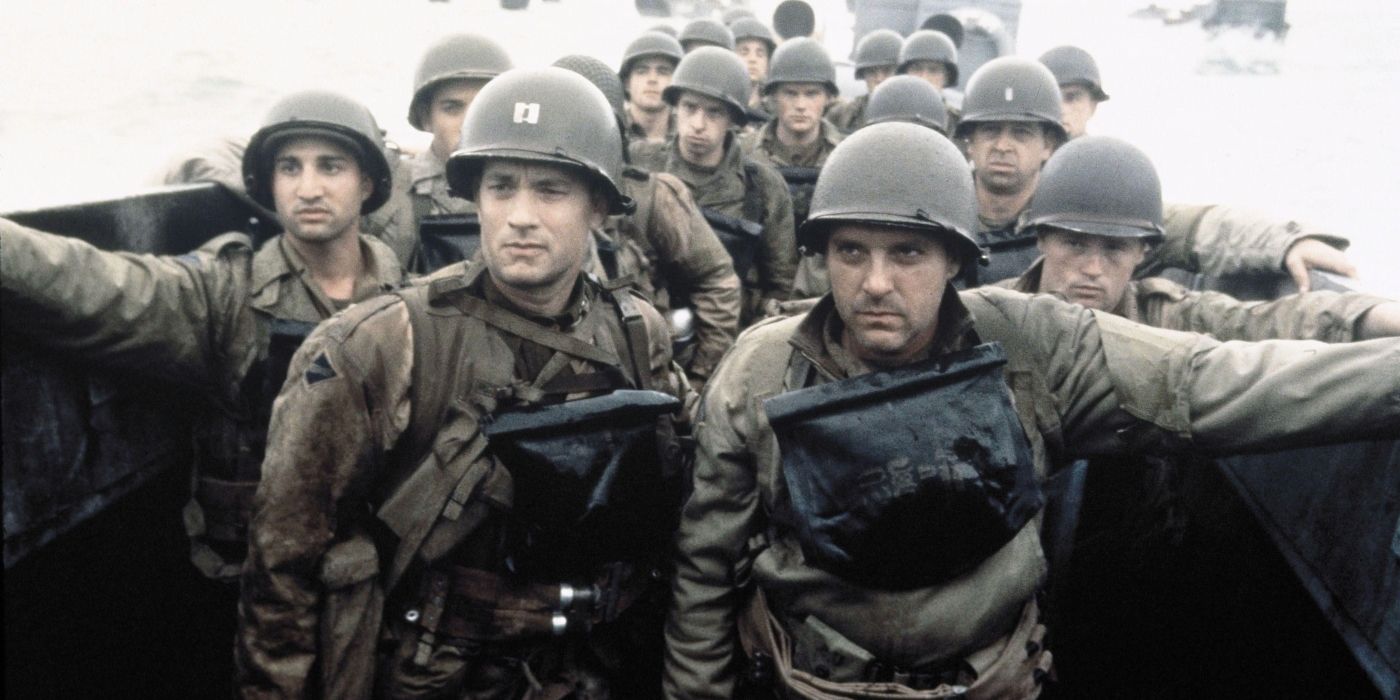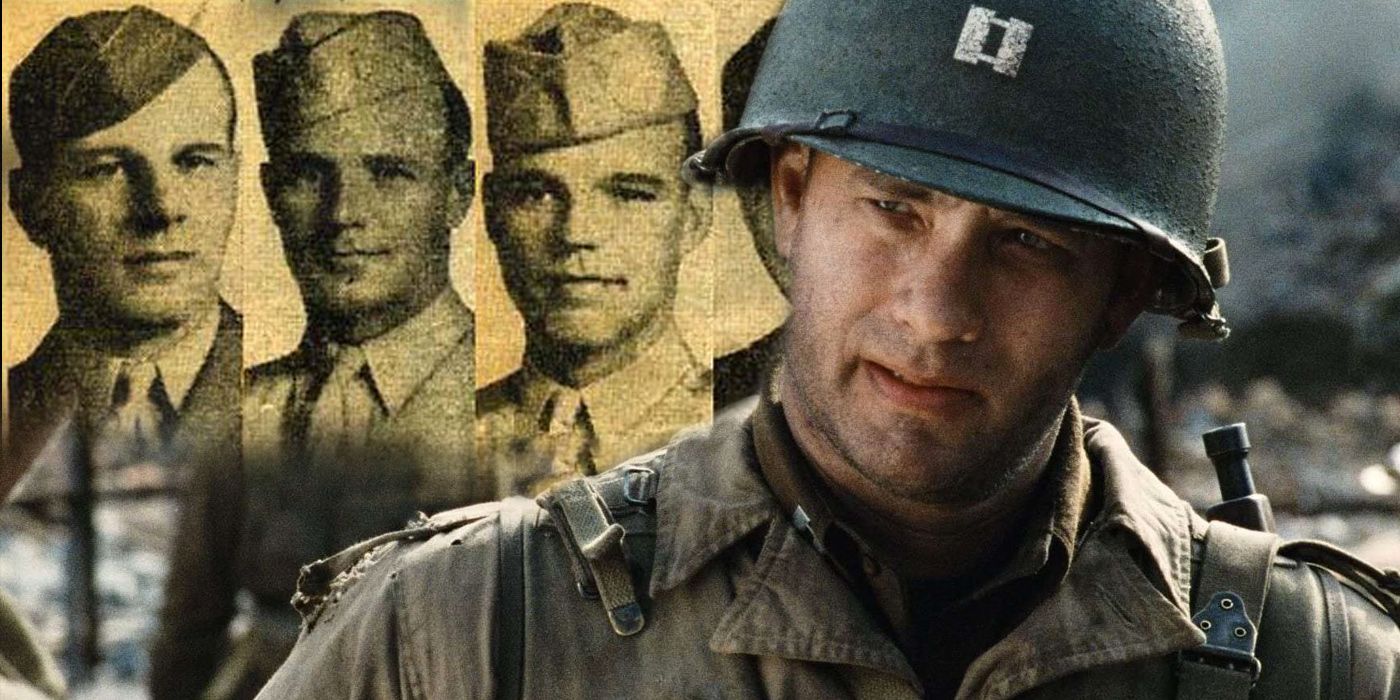Saving Private Ryan is remembered as one of the most harrowing and evocative Second World War movies ever made, culminating in an ending that is as visually spectacular as it is emotionally resonant. Steven Spielberg’s 1998 war movie won multiple accolades for its no-holds-barred portrayal of combat – particularly in its iconic D-Day opening sequence. However, while the Omaha Beach scene is rightly remembered as one of Saving Private Ryan‘s defining features, the film’s ending proves that the rest of the movie has much to offer.
After spending much of the story searching for the titular private, Saving Private Ryan‘s ending sees Captain Miller and his squad locate James Ryan (Matt Damon) in the town of Ramelle. After Ryan refuses to abandon his fellow soldiers, Miller and his men agree to help defend the town, engaging in a deadly battle against German forces. Although Miller and the majority of the rescue party lose their lives, Ryan escapes – a flash-forward revealing him standing with his family at the Normandy Cemetery. With devastating character deaths and weighty themes, Saving Private Ryan‘s ending has a lot to unpack.
“It Doesn’t Make Any Sense” – Why Private Ryan Refuses To Be Rescued
He Doesn’t Want To Abandon His Fellow Soldiers
One of the more complex elements of Saving Private Ryan‘s ending concerns why Miller and his team are forced to defend Ramelle in the first place. After finding Ryan on the outskirts of the town, Miller tells him that his brothers have been killed, and he has orders to bring him back home. Ryan, however, refuses, declaring that the situation “doesn’t make any sense“ and that he has no more right than any of the other men in his unit to be rescued. While Miller and his team are frustrated, they are ultimately unable to force Ryan to go with them – eventually concluding that they should stay and fight.
Ryan’s decision exposes a key theme of the film – the idea of duty. His loyalty to the rest of his unit highlights how service, for many real Second World War soldiers, was a more fundamental principle than personal safety. It also explores one of the movie’s core conflicts between the individual and the collective. While Ryan’s status as a final surviving brother is the catalyst for the story, in his mind this makes him no more significant than anyone with him on the front lines. It demonstrates that, behind every soldier, there is a personal story of tragedy and sacrifice that deserves to be told.
…Ryan’s decision is a complex and multifaceted one that speaks to many of
Saving Private Ryan
‘s core questions.
Ryan’s actions also highlight how the horror and trauma of war can create new bonds and relationships. The camaraderie – and occasionally the discontent – felt between members of Miller’s unit permeates the narrative and continues with Ryan. The sense of belonging he feels as part of the collective is typified by his statement to Miller that, when they tell his mother about his decision, he should tell her “when you found me, I was with the only family I had left“. Thus, Ryan’s decision is a complex and multifaceted one that speaks to many of Saving Private Ryan‘s core questions.
“Earn This”: What Captain Miller’s Dying Words To Private Ryan Really Mean
It Brings The Story Full Circle
In what is perhaps the most touching moment in the movie, the battle of Ramelle ends with Captain Miller (having been shot by the German soldier colloquially known as “Steamboat Willie“) dying on the bridge in Ryan’s arms. With his last breath, he instructs Ryan to “Earn this“. The movie then flashes forward to the present day, showing a surviving Ryan surrounded by his family at the cemetery.
Miller’s seemingly simple statement is loaded with meaning. His command is a direct reflection of the sacrifices both he and the other deceased members of his unit made in their rescue attempt. In essence, he is saying, “We sacrificed ourselves so that you could live your life. Don’t waste it.” Given Ryan’s qualms about being rescued in the first place, this is a powerful message that clearly resonates. However, the “Earn this” request is much more significant than an instruction to a single soldier.
Miller’s death represents the thousands of soldiers who died in Normandy and throughout the Second World War, and his parting words are a reminder to the viewer of their collective sacrifice.
With this phrase, Saving Private Ryan conveys a message both to its titular paratrooper and to the audience as a whole. Miller’s death represents the thousands of soldiers who died in Normandy and throughout the Second World War, and his parting words are a reminder to the viewer of their collective sacrifice. In this touching scene, Spielberg speaks to anyone watching the movie that the life they enjoy today is a result of the myriad micro-decisions taken by soldiers on the front line who sacrificed everything for other peoples’ freedoms.
Why Upham Kills Steamboat Willie After Failing To Help Mellish
It Follows Saving Private Ryan’s Most Brutal Scene
Many war stories explore the idea of innocence lost, and Saving Private Ryan is no exception. While most of the film’s characters are battle-hardened soldiers, one who goes against the grain is the unit’s inexperienced translator, Timothy Upham. Upham demonstrates his relative innocence throughout the story, from misunderstanding the meaning of “FUBAR“, to doing everything he can to prevent the extra-judicial killing of Steamboat Willie. However, this innocence is well and truly lost in one of Saving Private Ryan‘s most upsetting scenes.
While running ammunition between buildings, Upham stumbles across Mellish’s life-and-death fight with a German soldier. The combat is brutal and hand-to-hand, resulting in Mellish’s death by stabbing as Upham stands by, paralyzed with fear. This moment is haunting, both for the intimacy of Mellish’s death and Upham’s total psychological breakdown. However, while Upham failed to save Mellish, he emerges from the experience a different character – typified by his decision to shoot Steamboat Willie in the battle’s final moments.
Upham shoots Steamboat Willie for several reasons. Practically, his presence at Ramelle (not to mention his direct part in Miller’s death) suggests that Upham was wrong to advocate for his release when he was initially captured. Killing him is therefore partly down to Upham’s guilt over the original incident. However, more profoundly, it also relates to Upham’s growing understanding of the cost of war. He is no longer an idealist who believes in playing by the rules. At this moment, he recognizes that killing Steamboat Willie is the easiest way to ensure the other soldiers’ surrender. That he does so dispassionately demonstrates how his character has changed.
Saving Private Ryan’s Final Scene: Ryan Visiting Miller’s Grave Explained
It’s A Twist At The End Of The Movie
Saving Private Ryan‘s flash-forward brings the movie’s story full circle. Even though most people assume the movie’s opening is the D-Day sequence, the film actually begins with footage of a mysterious elderly man walking through a cemetery, eventually becoming overwrought with emotion. The action then switches to 1944, showing the perspective of Miller and other soldiers on the boat.
The revelation that the man in the cemetery is Ryan, not Miller, is an unexpected twist. The way the movie’s opening is filmed suggests that the elderly man is Miller reflecting on his experience on the beach. The movie’s ending, in which Matt Damon’s face slowly morphs into Harrison Young’s, completely flips this perspective. It is a double-edged reminder that, while Miller’s sacrifice was successful, his death on the bridge in Normandy was as final as it seemed.
In showing the generations that were saved by his and other soldiers’ actions, the importance of their sacrifice and heroism is reinforced.
Through this ending scene, Spielberg hammers home the message first hinted at through Miller’s “Earn this” line. In showing the generations that were saved by his and other soldiers’ actions, the importance of their sacrifice and heroism is reinforced. It is a poignant moment that directly links the events of the movie to the present day, demonstrating that while the Second World War might feel remote, almost everyone has a direct connection to the conflict.
Who Dies In Saving Private Ryan & Who Survives
The Body Count Really Piles Up
After the carnage of the opening sequence, Saving Private Ryan is relatively restrained when it comes to main character deaths until the end of the movie. As Miller’s team conducts their operation, the only two members to fall before the battle at Ramelle are Caparzo (Vin Diesel) and Wade (Giovanni Ribisi). However, this changes during the battle of Ramelle.
|
Saving Private Ryan Main Characters |
Status At The End |
|---|---|
|
Captain John H. Miller |
Dead |
|
Richard Reiben |
Alive |
|
Mike Horvath |
Dead |
|
Timothy Upham |
Alive |
|
Mellish |
Dead |
|
Jackson |
Dead |
|
Wade |
Dead |
|
Caparzo |
Dead |
|
James Francis Ryan |
Alive |
In addition to the aforementioned Miller and Mellish, other key deaths (alongside a multitude of unnamed German and American soldiers) include Jackson, Horvath, and Steamboat Willie. By contrast, the most significant characters to survive the final battle are Ryan himself, Upham, and Edward Burns’ rebellious soldier, Reiben. However, while these characters are crucial to the movie’s main narrative, Saving Private Ryan effectively conveys that war is much more than individual stories and that there were many survivors and casualties throughout.
Saving Private Ryan’s True Story: How It Compares To The Real-Life D-Day & How Much Happened?
The Movie Mixes Fact With Fiction
Saving Private Ryan is a complex blend of meticulously researched, fact-based story-telling, and fictional characters and settings. Moments like the opening on Omaha Beach are infamously realistic – to the point where many veterans were reportedly unable to sit through the scene owing to how closely it mirrored their own experience. While some details (like bullets killing soldiers underwater), distort reality, Saving Private Ryan‘s opening is widely regarded to be one of the most accurate and realistic representations of the D-Day landings in cinema history.
Miller and his unit are completely fictional, as are many of the engagements – including the climactic battle at Ramelle.
However, while this and other moments are true to life, the movie also contains multiple inaccuracies. For instance, even in the opening scene, there are several historical omissions, such as the massively condensed time period, the lack of participation of soldiers from other Allied powers, and what was happening on the other beaches involved in the D-Day landings. Further, Miller and his unit are completely fictional, as are many of the engagements – including the climactic battle at Ramelle. As a result, while the movie’s opening reflects a real story, much of the rest of Saving Private Ryan is fictitious.
What Happened In World War 2 After Saving Private Ryan
The Movie Takes Place Over A Limited Time Frame
Although the events of Saving Private Ryan make for a compelling story, they offer just a snapshot of the wider Second World War conflict. While the movie’s timeframe is unclear, most of the action seems to take place within a few weeks of the D-Day landings in June 1944. This means that, by the movie’s end, there was still over a year before the wider war eventually came to a close on September 2nd, 1945, following the Japanese surrender.
Given how long it took the Allies to achieve victory post-D-Day, there are clearly many significant events that happened after Saving Private Ryan‘s ending. Indeed, entire books have been written about the global conflict’s resolution, proving its complexity and broad historical significance. However, while different sources emphasize different details, there were multiple major events on which everyone agrees.
In Europe, the rest of 1944 saw the Allies push inland, finally liberating Paris in August 1944. After the abortive attempt to invade Germany through the Netherlands (Operation Market Garden), December 1944 saw the beginning of the Battle of the Bulge (memorably depicted in the Band of Brothers episode “Bastogne”). While the Pacific theater saw major fighting in the Philippines and Burma, Europe saw the Allies cross into Germany in March 1945. The Battle of Berlin began in April, resulting in Germany’s unconditional surrender in May 1945. After the atomic bomb detonations in Hiroshima and Nagasaki, Japan’s surrender followed.
What Happened To The Real-Life Brothers Who Inspired Saving Private Ryan
The Movie Has A Real Inspiration
Although much of Saving Private Ryan‘s narrative is fictional, the film does have some true story inspiration. The central plot device of a family of brothers being killed in action, prompting Army Command to pull the final surviving sibling out of combat is based on the story of the Niland brothers. In reality, three of the four Niland brothers were believed to have been killed in action, although one was later revealed to have survived a Japanese POW camp. Nevertheless, the situation compelled the Army to extract the youngest, Fritz Niland, from France. This provided the inspiration for Matt Damon’s character from the film.
The Niland brothers’ story was conveyed in Stephen E. Ambrose’s bestseller,
Band of Brothers
, which went on to inspire the HBO miniseries.
Of course, the precise circumstances surrounding Fritz Niland’s extraction were very different from what is seen in the film. For starters, Niland’s orders were relayed by a single man – Father Francis Sampson. Unlike Tom Hanks’ Captain Miller, Sampson was a chaplain in the army who parachuted by himself behind enemy lines in order to get Niland out of the firing line. Fritz Niland survived the war, living until 1983. Eldest brother Edward Niland also lived until the 1980s, although the middle two Niland brothers, Preston and Bob, were both killed in action in Normandy.
The Real Meaning Of Saving Private Ryan’s Ending
The Movie’s Ending Explores The True Meaning Of War
Saving Private Ryan‘s ending is a complex examination of the purpose of war. With its opening scene and sporadic violence throughout, the movie often feels nihilistic and hopeless. The hell of Omaha Beach is conveyed coldly and dispassionately. Men are mown down without hesitation or quarter, highlighting the dehumanizing consequences of conflict. The impression, effectively conveyed, is that war can cause anyone to lose their sense of compassion and humanity – a journey typified by characters like Upham, who wear their lost innocence heavily.
However, Saving Private Ryan‘s final moments offer a sense of hope – albeit one tempered by tragedy. In seeing the elderly Ryan with his family, the audience is reminded that the violence and the horror are not completely in vain and that some good can still come out of the most horrific circumstances. The movie posits that, while war itself is unremittingly brutal, the choices made by individuals can still have far-reaching consequences. It is a reminder to everyone of what was lost for freedom in Europe and a challenge to the audience to “earn” the life they now have.
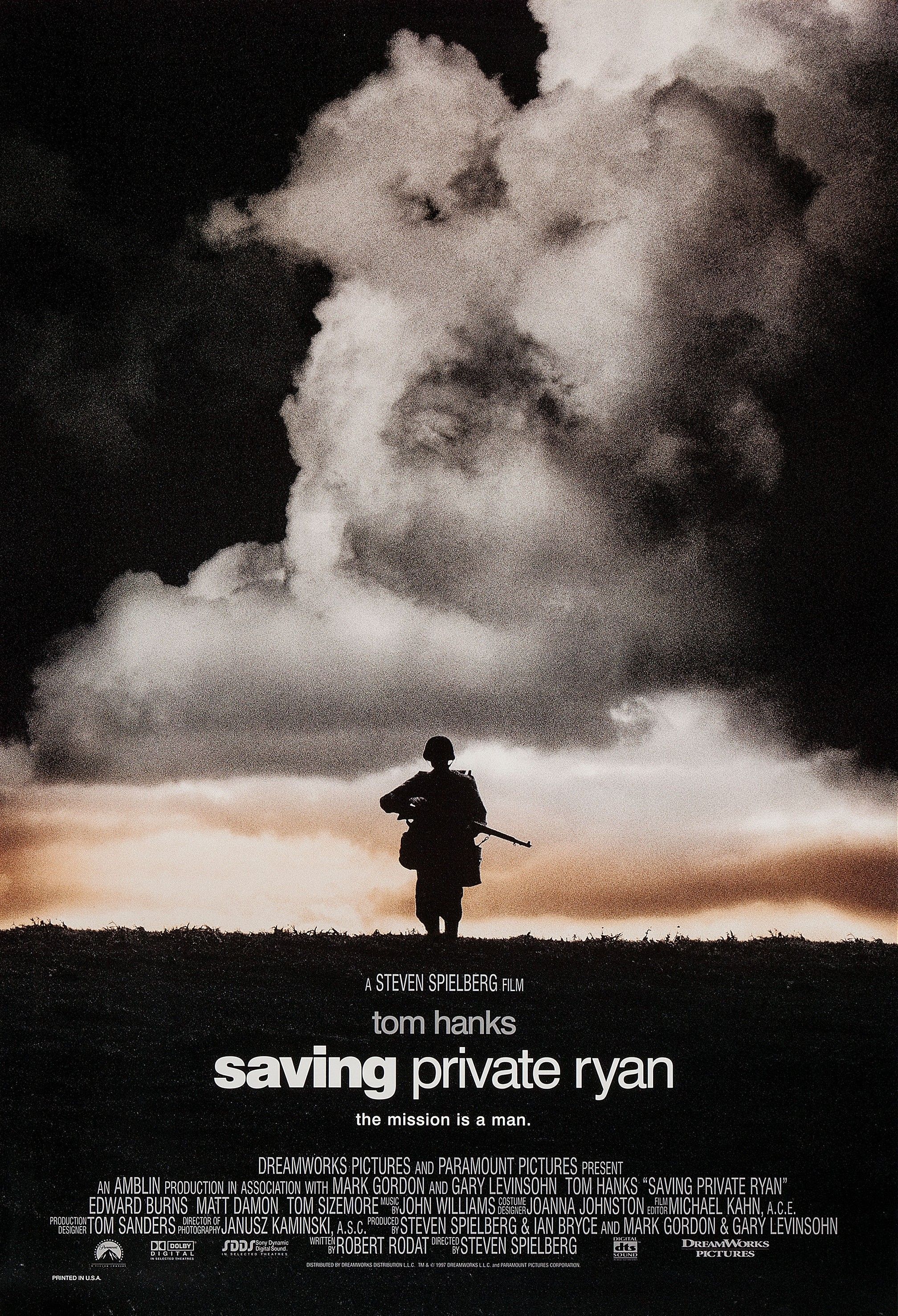
- Release Date
- July 24, 1998
- Runtime
- 169 minutes
- Budget
- $70 million



